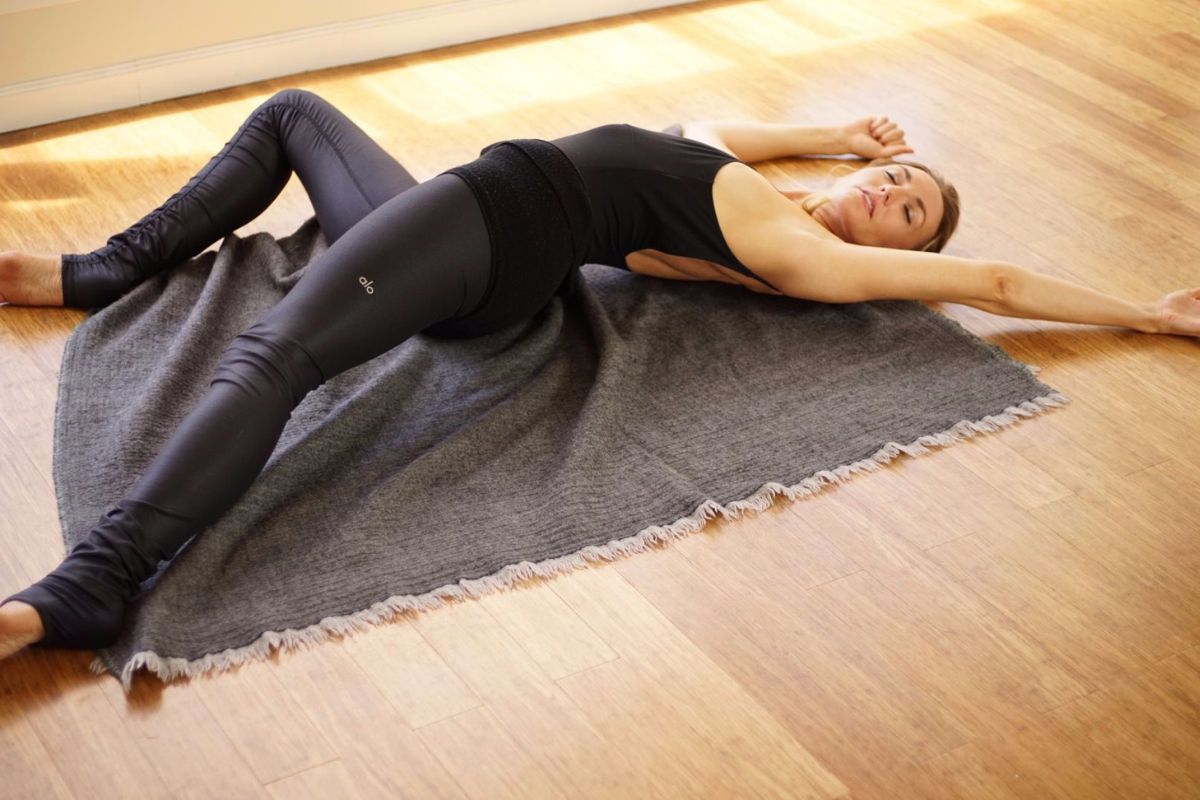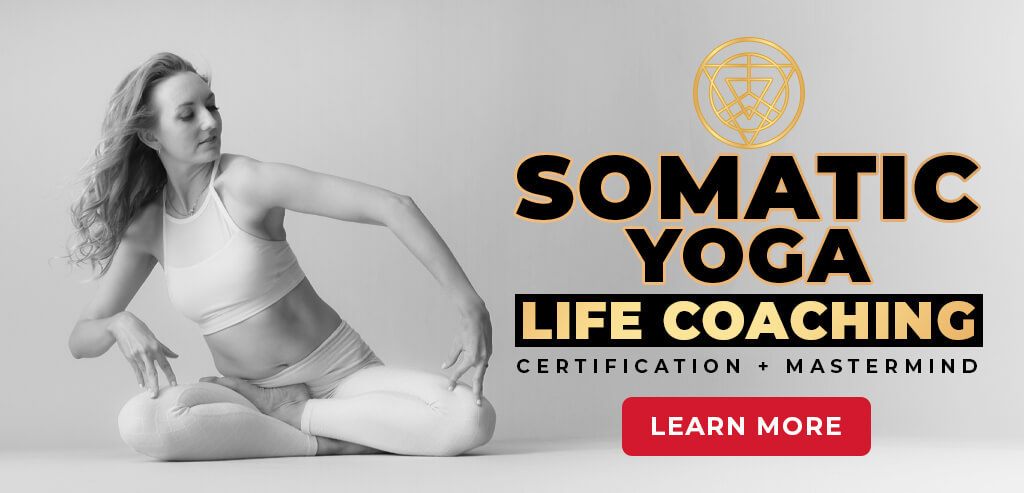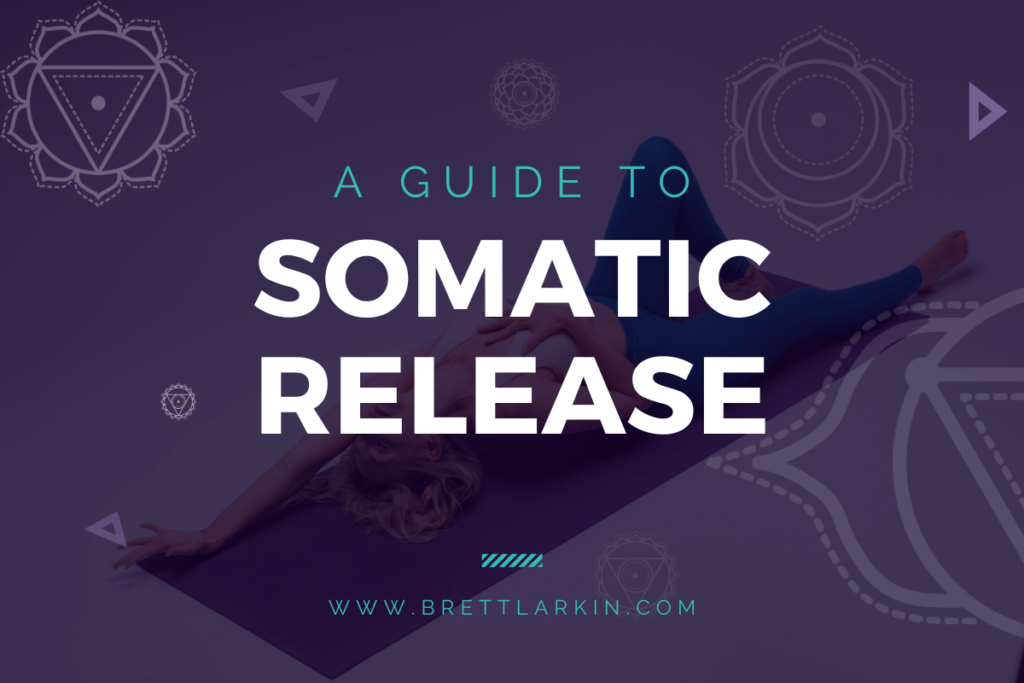I’ve been teaching yoga for many years before I learned about somatic release.
So, if you’re like me, and you’re wondering what it is—know you’re not alone!
In recent years, I’ve tried somatic therapy and it has been a total game-changer.
We can do all the talk therapy in the world and while it helps, the body needs to release stored traumatic memory.
That’s what somatic release is! It’s clearing out an old traumatic event from your entire system – mind, body, and soul. Traditional talk therapy serves it’s purpose, but for me personally, the biggest leaps happened on a cellular level when I was able to step out of survival mode and into a relaxed state.
From there, I’ve had one somatic experience after another—and I want that for you too!
So, to get started, let’s talk about what a somatic release is and how it can benefit you, especially if you’ve experienced trauma.
What Is Somatic Release?

Picture this: you’re on your yoga mat, ready to flow through your favorite asana.
But instead of just focusing on the poses, you start to tune into something deeper – the sensations in your body and the emotions they might be holding.
Somatic release involves a holistic approach to healing, focusing on the mind-body connection to facilitate the release of tension and trauma stored within the body.
Somatic release is like giving your body a big, warm hug. It’s about getting into a state of deep self regulation where you’re able to release stress and begin processing past traumas.
When you start letting go of any tension or stress that’s been hanging around, whether it’s from a tough day at work or something deeper like past trauma, you open the doorway for somatic release to happen. We’re talking about unlocking those knots, both physical and emotional, that might be keeping you from feeling your absolute best. And letting past events that might be trapped in your body to release through somatic experiencing.
Somatic Therapy Example
Let me share an extreme example. Let’s say Sally has traumatic memories of a car accident. When it happened, her upper body braced and she experienced trauma, as well as broke her arm. Even after her body healed, she’s had chronic pain that won’t go away. Her body holds the traumatic memory of her freeze response from the accident—and until it’s released through somatic work, she might experience mental health and physical symptoms, and maybe even physical pain, stemming from her nervous system response during the accident.
Sally meets with a somatic therapist and together in somatic therapy, they work to regulate her nervous system and help her notice her physical sensations. Her chronic anxiety starts to melt away and through body movement and breathing exercises, her mind and body are able to release the stored past traumatic event.

Getting Started with Somatic Therapy
So, how can you do this too? Through specific exercises, like mindful movement (yoga!), deep breathing (breathwork), and maybe a sprinkle of self-massage (pleasure first!). To get into that relaxed state, you can explore gentle stretches and flowing sequences that invite you to tune into what your body is telling you. It’s like a dance between your breath and your body, helping you release anything that no longer serves you.
What is Somatic Yoga – 5 Min Explainer Video 👇
By tapping into the wisdom of your body, somatic release can be a powerful tool for healing and transformation. It’s not just about stretching muscles – it’s about stretching your capacity for joy, resilience, and self-love.
When you slow down, you’re able to notice your physical sensations. This is also known as somatic awareness. Through somatic therapies, you start to increase your body awareness and your mind body connection. Your nervous system regulates and you can tune into what’s behind any chronic pain or physical symptoms.
If you work with a mental health professional or one of many trained somatic therapists, they might lead you through specialized training in therapy sessions, like sensorimotor therapy, eye movement desensitization, EMDR therapy, and other somatic experiencing exercises.
If you’ve been diagnosed with post traumatic stress disorder, somatic therapy can be extremely healing for your mind body connection. A somatic therapist can help you with somatic therapy exercises and your mental health to work through the traumatic events, the painful emotions, and your trauma response. Somatic psychotherapy is a great way to upend deeply rooted beliefs and deal with trauma memories and negative emotions.
Experience My Somatic Yoga Workshop (usually $67) FREE!👇

Benefits Of Somatic Release

Somatic therapy offers a plethora of benefits that can positively impact both your physical and emotional, and spiritual well-being.
As we delve into this practice, it’s really important to understand the wide-ranging advantages it brings.
Here are some of the amazing benefits:
- Stress Reduction: Somatic therapies help activate the parasympathetic nervous system, promoting relaxation and reducing stress levels. A study in the Journal of Bodywork and Movement Therapies suggests that practices like mindful movement (ahem…yoga!) can significantly decrease stress and anxiety levels.
- Improved Emotional Regulation: Somatic therapy allows you to become more aware of your bodily sensations and responses to emotions, fostering more emotional resilience. For anyone with post traumatic stress disorder, this is a major benefit of somatic therapies.
- Release of Physical Tension: Somatic experiencing targets areas of physical tension, helping to alleviate stiffness, soreness, and discomfort in the body. A study in the International Journal of Yoga Therapy demonstrates that somatic practices – like the Hakomi Method – can effectively reduce muscle tension and improve flexibility.
- Trauma Healing: Somatic therapy is particularly beneficial for individuals who have experienced trauma. By engaging in gentle movement and body-centered practices, trauma survivors can safely process and release stored trauma, promoting healing and integration. Research in the Journal of Trauma & Dissociation highlights the efficacy of somatic experiencing in treating trauma-related symptoms.
- Increased Energy Flow: By releasing blockages and restoring balance within the body, somatic healing promotes the smooth flow of energy (prana) – leading to more vitality, rejuvenation, and an overall sense of aliveness.
What Are Somatic Exercises?

Somatic therapy exercises include mindful movement and body-centered practices aimed at facilitating the release of physical tension, emotional stress, and trauma stored within the body.
These exercises focus on cultivating awareness of bodily sensations, promoting relaxation, and restoring balance to your nervous system.
Here are a few of the most common forms:
Somatic Shaking
You know how dogs shake after they feel stressed? That’s somatic shaking!
Somatic shaking involves rhythmic, spontaneous movements of the body to release tension and stress. It’s a natural response observed in animals and humans as a way to discharge excess energy and reset the nervous system.
However, in modern society, we’ve been taught to counter this natural movement and heal the mind. But sometimes the best therapy session for our nervous systems is to simply shake it off!
By engaging in somatic approaches with gentle shaking movements, you can release held tension and promote relaxation on a cellular level.
Body Scan Meditation
This is a key way to release negative emotions or a traumatic experience from the body. It’s one of my favorite somatic approaches!
Body scan meditation involves systematically directing attention to different parts of the body, noticing any sensations without judgment. Think of deep relaxation in savasana.
This practice cultivates deep, deep body awareness, allowing you to identify areas of tension and consciously release them. This must be done in a secure space where you feel safe and won’t be interrupted. No external stimulus allowed!
Breathwork
Of all the mind body techniques in the world, breath work is the most powerful. Your breath is the lever you must pull to control your nervous system and get into the present moment. Mind body healing can only happen when we are in a state of regulation.
Somatic breathwork techniques, such as diaphragmatic breathing and breath awareness, are integral to somatic therapy exercises. Again, conscious breathing helps regulate your whole system, induce relaxation responses, and release physical and emotional tension stored in the body.
By focusing on the breath, you can deepen your connection with the body and process traumatic experiences.
Mindful Movement

Yoga is the ultimate somatic therapy if you incorporate mindful movement. So many of us have gone to studio classes that are more about pumping sweat than getting centered. Intentional movements paired with deep breathing are the key.
Through mindful movement, you can release tension, improve your flexibility, and feel better all around.
Try my beginner somatic release yoga class:
You can read more about somatic yoga benefits to get an idea of how this mindful movement will impact your life.
Progressive Muscle Relaxation (PMR)
One therapeutic approach I love is progressive muscle relaxation. This is similar to body scan, except you intentionally focus only the mind on different areas of the body. Sometimes, it involves systematically tensing and relaxing different muscle groups.
This practice helps you become more aware of muscle tension and learn to release it intentionally, which helps in releasing traumatic experiences too. PMR is often used therapeutically to manage anxiety, insomnia, and chronic pain.
Body-Oriented Psychotherapy
Body-oriented psychotherapy is usually done with a somatic therapist, and sometimes known as sensorimotor psychotherapy. Other forms include Somatic Experiencing and the Hakomi Method, which integrate somatic awareness with traditional psychotherapeutic techniques.
These approaches recognize the interconnectedness of mind and body, using somatic exercises to facilitate the processing and release of trauma stored in the body, leading to profound healing and transformation.
By incorporating any of these somatic exercises into your daily routine, you can tap into the body’s innate wisdom, release tension and stress, and utilize these other techniques to feel calm, cool, and collected.
A therapist helps, but you should take your time to find the right therapist. Additionally, you don’t need a therapist to get embodied and experience somatic therapy on the mat.
Your traumatic experiences are waiting to be released and you have the power to make that happen.
How To Release Tension In Body

If you’re ready to integrate somatic therapy practices into your life, you can start by following 4 simple steps:
Step 1: Check-in with your body
Start by finding a quiet and comfortable space where you can tune into your body without distractions. Close your eyes and take a few deep breaths, allowing yourself to become fully present in the moment. Notice any areas of tension or discomfort in your body without judgment.
Step 2: Get into a relaxed state
With eyes closed, take slow, deliberate breaths, allowing each inhale to replenish you and each exhale to release tension. Let your awareness settle on your body, welcoming a state of calmness and ease.
Find a yoga pose which gets you into a state of deep relaxation. You might need to move first, then settle into a regulated state.
Step 3: Use your intuition to choose a somatic therapy exercise
Use your innate wisdom to guide you in selecting a somatic therapy exercise that resonates with your body’s needs.
Trust the signals your body sends you as you explore various techniques. Whether it’s gentle movement, breathwork, or meditation, let your intuition lead the way to your optimal somatic therapy practice.
Step 4: Integrate, reflect, and rest
Take a moment to reflect on how your body feels after practicing these somatic therapy techniques. Notice any shifts in your physical sensations, emotions, or overall sense of well-being.
Allow yourself to rest and integrate the benefits of your practice, knowing that you’ve taken an important step towards releasing tension and nurturing your body.
Common Questions About Somatic Release

If you still have questions, you’re not alone. Somatic therapy is complex and can take a while to understand, especially since it’s so different from other forms of healing we’ve learned.
Is crying a somatic release?
Crying is definitely a form of release!
When we cry, we release pent-up emotions stored in the body, like sadness, frustration, or grief. These emotional releases can manifest as tears, trembling, or other bodily sensations.
Crying allows us to release emotional tension, giving us a sense of catharsis and much-needed relief.
What does a somatic release feel like?
A somatic release can feel different for everyone, but common sensations include a sense of lightness, relaxation, and emotional release.
It may feel like tension melting away from the body, muscles softening, and a deep sense of peace washing over you. Some people may also experience tingling sensations, warmth, or a feeling of energy flowing freely. In EMDR therapy and sensorimotor psychotherapy, the release may feel more subtle.
How do you release trauma trapped in the body?
A therapist helps but you can also release on your own, especially on the mat. You just need to engage in somatic therapy practices that facilitate the processing and integration of traumatic experiences, like the ones listed above.
By cultivating awareness of bodily sensations, emotions, and triggers, you can safely process and release trauma. It’s important to seek support from trained professionals and significant people in your life when addressing complex trauma or PTSD.
Final Thoughts
Somatic therapy is a powerful tool in your healing journey.
If you’re ready to go deep into embodiment, I want to invite you to Embodied Yoga Life Coaching. This training is an intensive deep dive into your own personal development. You’ll also benefit from the friendship, expertise, networking, and support of like-minded professionals in your handpicked cohort.
Next Steps
- Take a deep dive into embodiment and somatic yoga with my Somatic Yoga certification program.
- If you’re interested in practical kriya yoga as a way to improve your daily life and relationships, check out my Yoga for Self Mastery course.

FREE Embodied Yoga Workshop (usually $67) Somatic Techniques & Cord Cutting Ritual

YOU MIGHT ALSO LIKE
- The Perfect Yoga Practice For Your Menstrual Cycle Energy Levels
- Enhancing Your Practice: The Benefits of Yoga and Nature Connection
- Gentle Somatic Yoga for Back Pain: Relief and Prevention Techniques
- How Somatic Yoga for Anxiety Can Help You Find Calm and Balance
- Somatic Stress Release Techniques for Emotional Balance
- Progressive Muscle Relaxation Meets Yoga for Deep Sleep
- 5 Somatic Hip Exercises For Beginners
- How To Relieve Myofascial Pain with Yoga: Heal and Prevent Muscle Tension
- Somatic Energy Healing: Techniques to Realign and Restore Balance
- How Somatic Shaking Can Release Tension and Reset Your Nervous System
- How To Create Mindful Somatic Yoga Sequences Your Students Will Love
- Somatic Yoga Poses For Every Body And Mind
- 6 Hip Openers For Emotional Release
- What Are Myofascial Release Trigger Points?
- Integrating Mind and Body: The Benefits of Somatic Bodywork









